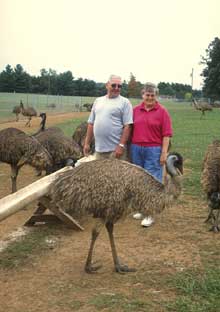Emus as a New Livestock Species
Emus grow to around 2 metres tall, weigh up to 50 kilograms and can live as long as 20 years. Because they are flightless, emu are strong runners and can reach speeds of 60 km/hr in short bursts. Emus become reproductivly mature around the age of 2 or 3. Each mature breeding pair produces 20 to 50 eggs per year. The eggs are dark green, approximately 5 inches long, and weigh on average 600 grams.
Emu ranching is one of the fastest growing livestock industries in North America. The expanding emu population in the United States is locally bred and the American emu is quickly becoming the industry norm. Emus are tough, hardy birds that adapt well to most climates and conditions. They exist on a simple diet and require up to four gallons of water daily.They also do not require prime farm land allowing for marginal land not suited for crops to be utilized.
Emus are total useable and byproducts include: red meat, similar to lean beef; penetrating oil, used in cosemetics and the treatment of muscle and joint pains; hide, used to manufacture leather products and emu eggs, feathers and toenails which can be used for crafts and jewelery.
Contributed by Nancy Thornton
Photo source: The USDA Online Photography Center

